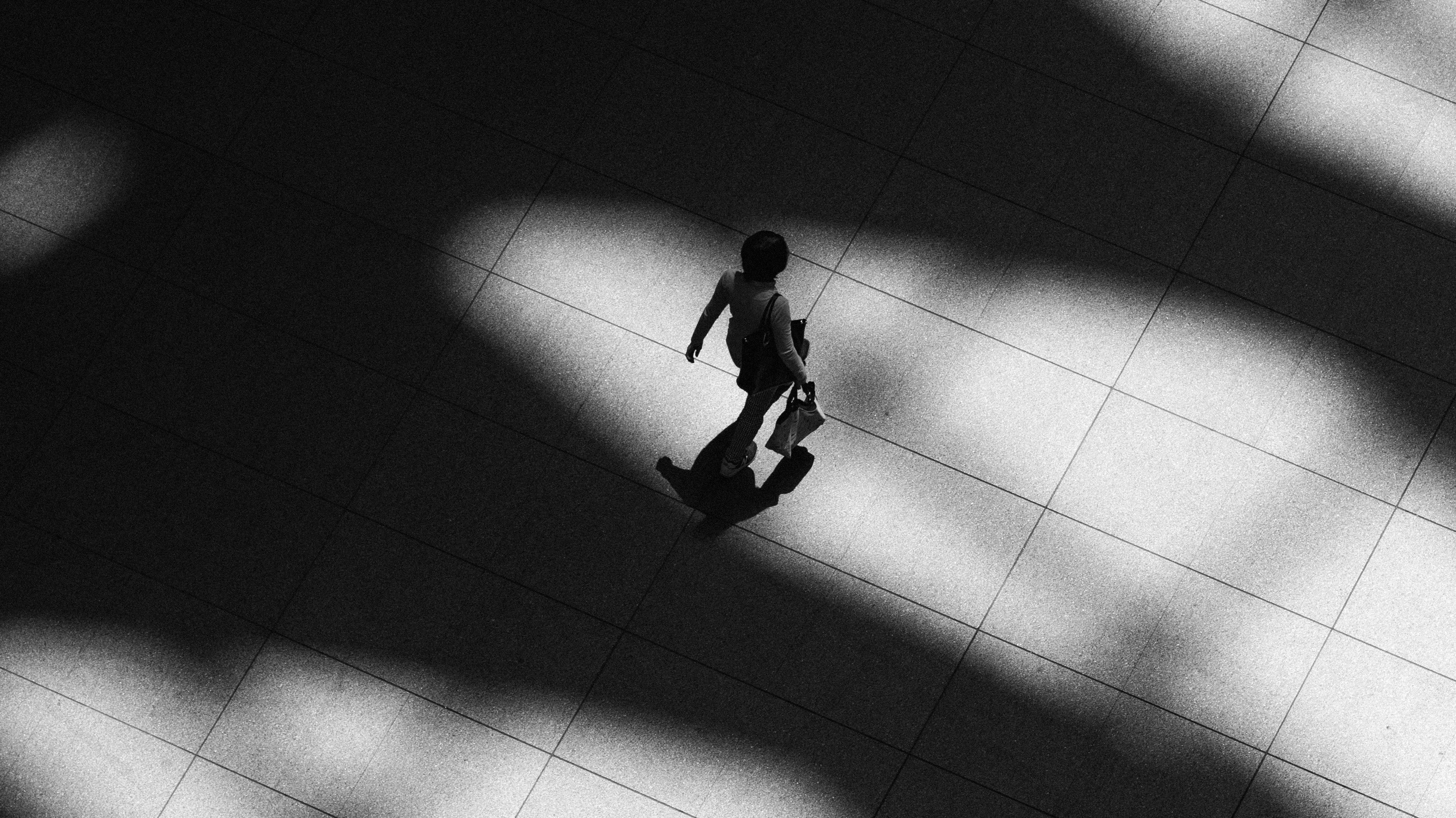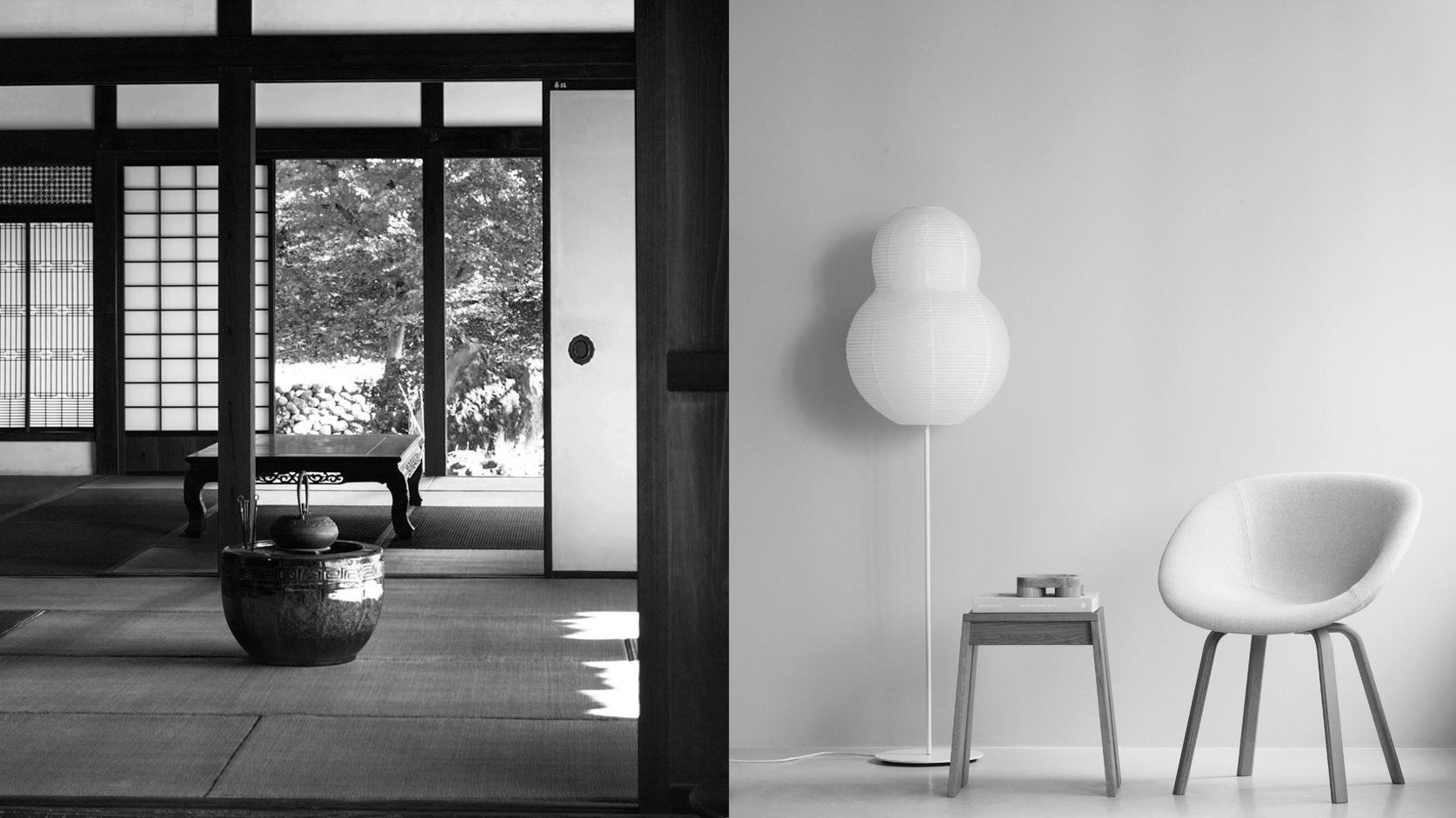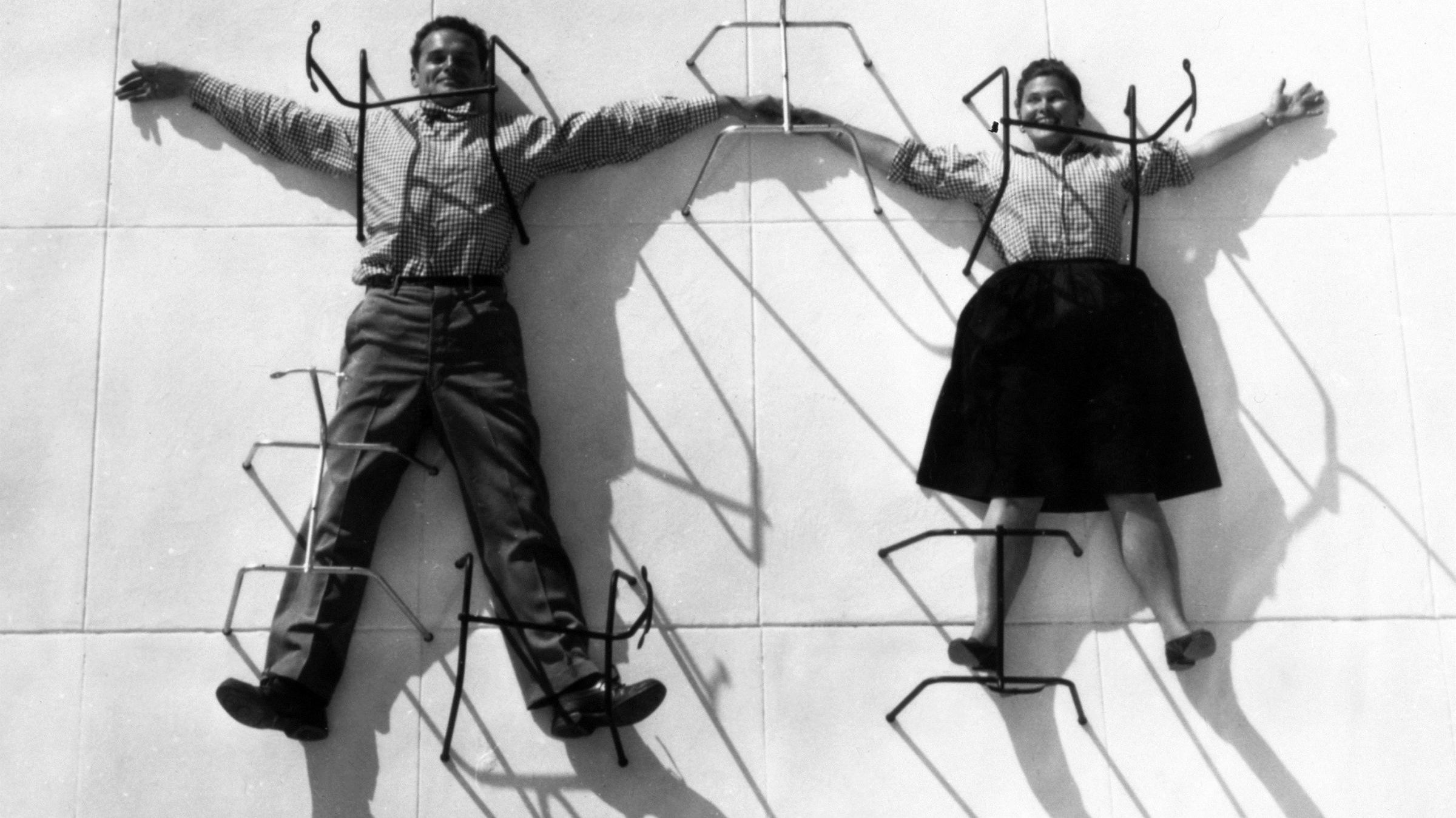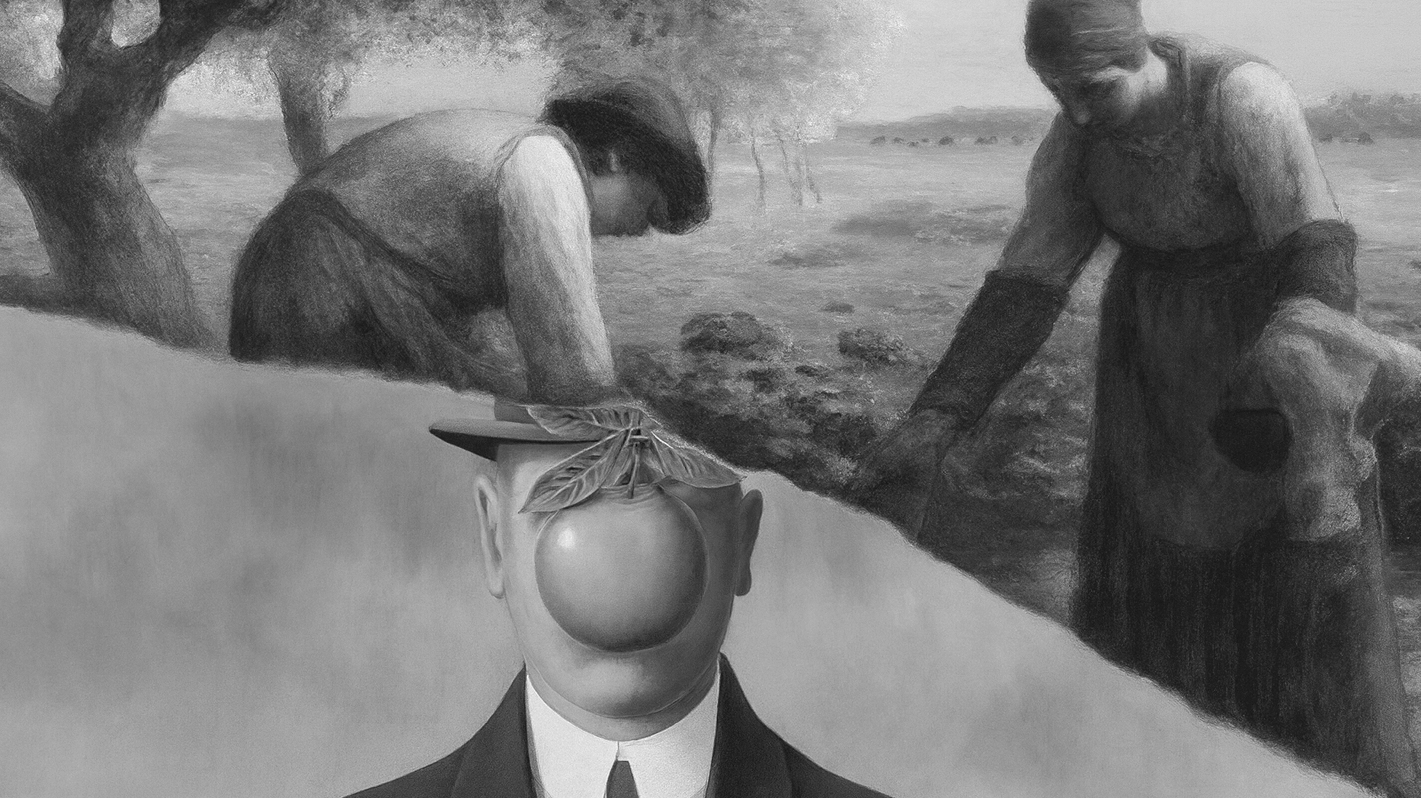Minimalism has become a trend in recent years, a term most of us associate with decluttered living spaces, sleek designs, and simplified wardrobes. The idea of "less is more" has gained significant popularity, especially in a world often overwhelmed with information and choices. However, minimalism is not a new concept; it has deep roots, and one of its most influential expressions is found in the minimalism art movement. In this article, let's explore this art movement and understand why minimalism continues to have such a profound impact.
(Minimalism in Art: Definition, Characteristics and Artists - dans le gris)
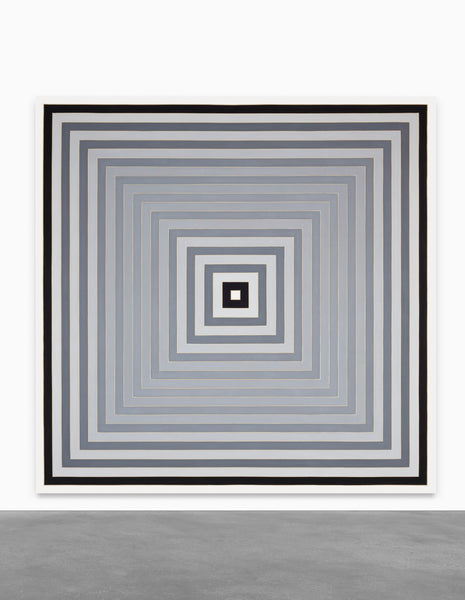
Photo Credit by Sotheby's; Frank Stella, Pratfall, Acrylic on Canvas
What is the Minimalism Art Movement?
(Minimalism in Art: Definition, Characteristics and Artists - dans le gris)
The minimalism art movement, which emerged in the mid-20th century, is a significant and influential artistic style characterized by a commitment to simplicity, reduction, and the exploration of fundamental elements in visual art.
Minimalism, or minimalist art, is regarded as an extension of abstract art and is characterized by the elimination of fundamental forms to unveil the purity and beauty of the art object. However, unlike many forms of abstract art, minimalism does not carry an underlying meaning or deeper understanding. Instead, it places its focus on aesthetics, structure, and texture rather than the artist's individuality or self-expression. During its time, the minimalism art movement was innovative in its approach, as artists emphasized the true essence of the medium and materials to create their art.
(Minimalism in Art: Definition, Characteristics and Artists - dans le gris)
(Minimalism in Art: Definition, Characteristics and Artists - dans le gris)
According to the definition from the Cambridge Dictionary, "Minimalism is a style in art, design, and theatre that utilizes the smallest range of materials and colors possible, and only very simple shapes or forms." Over time, minimalism has evolved to encompass different meanings for various people. Minimalism is not limited to art; it can also be applied to various aspects of life, including living, architecture, fashion, design, literature, music, and home decor. Words that best describe minimalist ideas include reductionist, simplicity, uncluttered, smooth, and essentially anything that conveys the fundamental aspects of an artwork. While these applications are common in modern times, it is helpful to gain context on how minimalism has evolved over time to become what it is today.
• Further Reading: Minimalist Interior Design: Key Principles and What You Need to Know
(Minimalism in Art: Definition, Characteristics and Artists - dans le gris)
History of the Minimalism Art Movement
(Minimalism in Art: Definition, Characteristics and Artists - dans le gris)
Origins and Influences
(Minimalism in Art: Definition, Characteristics and Artists - dans le gris)
Minimalism is an art movement that developed in the USA in the early 1960s among artists who consciously renounced recent art they considered stale and academic. Drawing inspiration from constructivism, De Stijl, and Marcel Duchamp's readymades, minimalist artists rejected the heroic narratives of Abstract Expressionism in favor of pared-down, purely self-referential geometric forms. A wave of new influences and the rediscovery of past styles led younger artists to question the conventional boundaries between different media. This convergence of ideas, from geometric abstraction to Constructivism and the concept of readymades, played a pivotal role in shaping the minimalism art movement.
Due to the post-war consequences and living conditions, people experienced a shortage of supplies, resulting in limited options for even their basic necessities. The minimalism movement began in the 1950s with a group of artists who didn't create traditional paintings and sculptures representing objects from the world, such as houses, bottles, or snowy landscapes. Instead, they focused on the materials they used, like paint, wood, and metal. Their artworks often resembled factory-made products. During that decade, a new group of artists emerged who used a vocabulary similar to that of modernist architecture—industrial materials with a geometric and minimalist character—but with a distinct artistic purpose in mind.
(Minimalism in Art: Definition, Characteristics and Artists - dans le gris)
Emergence in the 1960s
(Minimalism in Art: Definition, Characteristics and Artists - dans le gris)
Minimalism emerged as a reaction to the dominant art movement of the time, Abstract Expressionism. Abstract Expressionism was characterized by dramatic, emotional, and often large-scale paintings that emphasized individual expression and spontaneous creativity. However, as the late 1950s approached, many artists began to view this style as formulaic and thought that the art world had witnessed it enough. They sought a different approach that shifted away from the intense emotions and expressive brushwork characteristic of Abstract Expressionism.
In 1966, the Jewish Museum in New York held an exhibition called "Primary Structures," which played a pivotal role in establishing minimalism as a significant art movement. The exhibition featured the works of notable artists such as Judd, Morris, and Carl Andre and was one of the first shows to exclusively showcase minimalism. It received widespread critical acclaim and media attention, with both Time and Newsweek reporting on its success. The exhibition introduced the public to a new form of art that received various labels, including "ABC art," "Reductive art," and "Minimalism." Notably, the artists themselves, particularly Donald Judd, rejected these labels.
(Minimalism in Art: Definition, Characteristics and Artists - dans le gris)
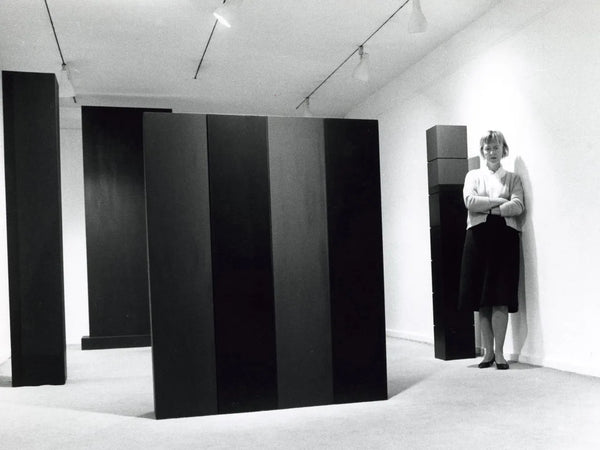
Truitt at the André Emmerich gallery, in 1963; Bridgeman Images courtesy Matthew Marks Gallery
(Minimalism in Art: Definition, Characteristics and Artists - dans le gris)
The Characteristics of Minimalism
(Minimalism in Art: Definition, Characteristics and Artists - dans le gris)
One of the key characteristics of minimalism is its rebellion against the expressive and abstract nature of expressionist art. Some even perceive it as rebellious because of its intention to convey the most basic and fundamental meanings through the use of colors and shapes. From an aesthetic perspective, minimalism offers refined beauty. It may also be seen as representing qualities such as truth (as it doesn't pretend to be anything other than what it is), order, simplicity, and harmony. The minimalist artist Frank Stella is renowned for his declaration, "What you see is what you see." Minimalism fully embraces this literalism by accentuating the physical properties of the art object, with a focus on geometry and color. Minimalist art is created purely for the sake of art, free from emotional attachments. These are a few of the key characteristics of minimalism:
(Minimalism in Art: Definition, Characteristics and Artists - dans le gris)
Repetition
(Minimalism in Art: Definition, Characteristics and Artists - dans le gris)
Repetition is a fundamental aspect of minimalism, playing a crucial role in the movement's aesthetic and philosophy. It is a recurring theme in minimalist art, serving to create a profound sense of visual rhythm and order. This use of repetition is not limited to visual arts alone; it extends into music, where minimalism often features repetition and gradual variation in its compositions.
Beyond aesthetics, repetition in minimalism also symbolizes endurance and timelessness. The consistent repetition of basic elements in minimalist art conveys a sense of permanence, emphasizing the enduring quality of the art. This enduring quality not only underlines the significance of minimalism in the art world but also contributes to its lasting appeal and influence across various art forms.
(Minimalism in Art: Definition, Characteristics and Artists - dans le gris)
Geometric Shape
(Minimalism in Art: Definition, Characteristics and Artists - dans le gris)
The use of geometric shapes in minimalism was significantly influenced by the aesthetics of industrial and architectural design that were prominent during the mid-20th century. Minimalism effectively employs geometry and the use of elements and shapes to maximize expressiveness with the available resources, thus creating a strong connection to the contemporary culture of that era. Artists in the minimalism art movement frequently utilize basic geometric shapes such as squares, rectangles, circles, and lines to craft their artworks. These shapes are selected for their inherent simplicity and the structural harmony they bring to compositions.
Robert Morris, "Untitled (Mirrored Cubes)", 1965-1971
(Minimalism in Art: Definition, Characteristics and Artists - dans le gris)
Simplicity
(Minimalism in Art: Definition, Characteristics and Artists - dans le gris)
Simplicity in structure and appearance stands as one of the defining characteristics of minimalism. As minimalism advocates for the reduction of art to its essential elements, this means stripping away any unnecessary or extraneous details, leaving only what is fundamental. It also means that minimalism rejects ornamental elements and flourishes often found in earlier art movements.
Minimalism is often considered to be more "pure" and streamlined than other art forms, characterized by minimal or imperceptible brush strokes and clear distinctions between colors. Not only visually, but in minimalism, the emotional or personal expression of the artist is minimized. The art is less about the artist's emotions and more about the objective qualities of the work itself.
(Minimalism in Art: Definition, Characteristics and Artists - dans le gris)
Limited Color Choices
(Minimalism in Art: Definition, Characteristics and Artists - dans le gris)
Another characteristic of minimalism is the use of color; minimalist art focuses on expressionless colors. Early works tended to be monochromatic, limited to one color and related hues (such as black, gray, and white). This makes minimalist artwork more neutral in its approach, and the color does not become more than what it is. The colors of minimalism are not used to convey personal expression but to convey impact and the work as it is.
(Minimalism in Art: Definition, Characteristics and Artists - dans le gris)
Precise and Hard-Edged
(Minimalism in Art: Definition, Characteristics and Artists - dans le gris)
Minimalist art seeks hard-edged, precise borders between areas of color. There is no shading or subtle transition. This is why the square and rectangle are so popular, as they provide specific shapes and hard edges. Hard-edged precision enhances the visual clarity of minimalism. Viewers can easily discern each individual color area and the relationships between them. This clarity contributes to the overall simplicity and immediate impact of the minimalist artwork.
(Minimalism in Art: Definition, Characteristics and Artists - dans le gris)
Lack of Expression
(Minimalism in Art: Definition, Characteristics and Artists - dans le gris)
Many earlier art movements, such as romanticism or symbolism, used art as a means to convey complex narratives or symbolism. In contrast, minimalism avoids narrative or symbolism. Most minimalist art lacks expression, as the minimalist artist does not reveal their personality or emotions in the artwork.
Minimalism places a strong emphasis on objectivity. When you stand in front of a minimalist artworks, you won't find big ideas, complex subjects, or social agendas. Instead, these paintings focus on geometry and color. The focus on form and structure is not driven by the desire to express emotions but to create a visual and intellectual experience.
In summary, minimalism is created for the sake of art rather than emotion. It emphasizes the aesthetic, structural, and formal qualities of the artwork rather than its emotional content. The art object is appreciated primarily for its inherent qualities rather than for the emotions it may convey.
(Minimalism in Art: Definition, Characteristics and Artists - dans le gris)
Industrial Materials
(Minimalism in Art: Definition, Characteristics and Artists - dans le gris)
In minimalism, materials played a crucial role in the creation of artwork. Minimalist artists favored raw, unadorned, and often mass-produced materials, showcasing their rejection of conventional craftsmanship and artistry ideals. Industrial materials are typically manufactured with precision and consistency, eliminating the need for individual craftsmanship and emphasizing the purity of form and material.
Minimalist artists frequently employed industrial materials like metal, concrete, and glass to create their works, emphasizing the inherent qualities and characteristics of these materials and their relationship with the surrounding environment. The preference for industrial materials in minimalism is a deliberate choice that underscores the movement's principles of objectivity, simplicity, and a focus on the essential qualities of materials and their relationship to the environment.
(Minimalism in Art: Definition, Characteristics and Artists - dans le gris)

Larry Bell, 20" Untitled 1969 (Tom Messer Cube)
(Minimalism in Art: Definition, Characteristics and Artists - dans le gris)
Focus on The Viewer
(Minimalism in Art: Definition, Characteristics and Artists - dans le gris)
In minimalism, the viewer's experience is a central consideration. In order to emphasize the relationship between the artwork and the viewer, minimalism often employs simplicity and a reduction of form to invite the viewer to engage with it directly and on their terms.
Donald Judd's "Untitled" (1969) is an example of such minimalism that prioritizes the viewer's experience. The artwork features identical rectangular boxes arranged in a grid pattern on the floor, made of stainless steel, and open on one side to create a hollow interior space. Viewers are encouraged to explore the artwork by walking around and between the boxes, experiencing it from various perspectives.
Another example, the work of Dan Flavin, known for his minimalist light installations. His piece "Untitled (to Barnett Newman to commemorate his simple problem, red or blue)" involves the use of fluorescent lights in various arrangements. When viewers step into the space where the installation is situated, they become an integral part of the artwork's transformation. The play of light and shadow, the interplay of colors, and the visual effects are all activated by the presence and movement of the viewer, creating an individual experience for each viewer.
(Minimalism in Art: Definition, Characteristics and Artists - dans le gris)
The Materials of Minimalism
(Minimalism in Art: Definition, Characteristics and Artists - dans le gris)
Minimalism often avoided traditional art materials in favor of manufacturing techniques, commercial materials, and industrial fabrication. By doing so, they aimed to eliminate any evidence of the artist's hand that might otherwise be evident in brushstrokes or other marks. In rejecting the notion that art should reflect personal expression or ideas, minimalist artists also eschewed the use of color to convey emotion or mood, choosing instead to use it primarily for spatial delineation.
To minimalism, house paint and fiberglass were more valuable materials than fine oil paints or clay. The use of industrial materials also reflected their intention to create objects that existed within the realm of everyday life, rather than as rarefied or precious objects. Overall, the use of unconventional materials and techniques played a key role in the minimalism art movement, contributing to its emphasis on simplicity, reduction, and physicality.
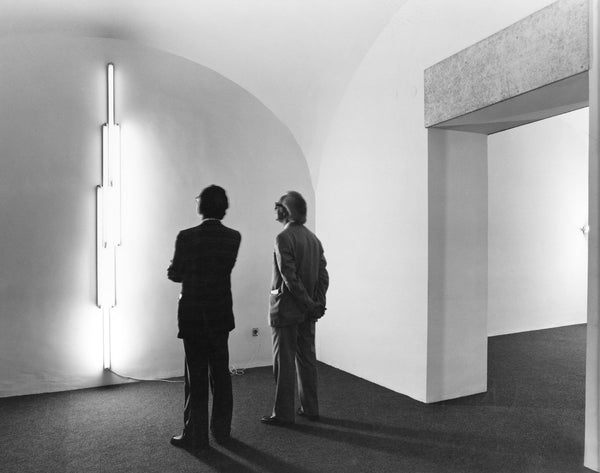
Photo Credit by Studio Trisorio; Dan Flavin Exhibition, Works from '67 to '70
(Minimalism in Art: Definition, Characteristics and Artists - dans le gris)
The Objections and Criticism of Minimalism
Despite minimalism's significant influence, it had its fair share of critics. As mentioned before, one of the most prevalent criticisms is that minimalism can be seen as lacking expressive content. Some argue that it lacks the depth and emotional richness found in earlier art movements, such as abstract expressionism. Critics argue that minimalism's emphasis on pure form and materiality can lead to art that comes across as cold and unfeeling. This brings to mind brutalist architecture, which similarly prioritizes simplicity, the reduction of ornamentation, and the use of industrial materials, often appearing austere and unapproachable to some.
Another criticism of minimalism is that the reduction of form and content can make the artwork appear superficial or lacking in substance. This reduction to the bare essentials may give the impression of shallowness, with some critics suggesting that minimalist works lack the depth and complexity found in more elaborate art forms. The focus on minimal elements can lead to art that seems one-dimensional or overly simplistic.
Furthermore, minimalism's reliance on intellectual discourse and art theory can be perceived as elitist, excluding those who may not possess a background in these areas. The movement's emphasis on conceptual elements sometimes makes minimalist art appear inaccessible to a broader audience and appealing only to a limited group of collectors and curators.
(Minimalism in Art: Definition, Characteristics and Artists - dans le gris)
Minimalist Sculpture
(Minimalism in Art: Definition, Characteristics and Artists - dans le gris)
In contrast to the more subjective abstract expressionists of the previous decade, some minimalists explicitly stated that their art was not about self-expression but rather "objective." Minimalism has taken many forms, with minimalist sculptors playing a key role in developing the concept of minimalism in art.
Minimalist sculptures aimed to create an awareness of space in the viewer. The artworks were arranged thoughtfully to highlight and expose the architecture of the gallery, often displayed on walls, in corners, or directly on the floor. The minimalist sculptors deliberately rejected the conventional pedestal or base, effectively eliminating the traditional sculpture approach. They regarded minimalist sculpture as just another object occupying space. By removing the barrier between the audience and the artwork, viewers were compelled to rethink their relationship with the artwork. Audiences could now interact with it at their own level, approaching, retreating, walking around it, and sometimes even standing on it.
The minimalist artist Robert Morris once said, "Simplicity of shape does not necessarily equate with simplicity of experience." Through this declaration, we believe that minimalist sculpture can be better understood by keeping an open mind and paying close attention to the artists who pioneered its ways.
(Minimalism in Art: Definition, Characteristics and Artists - dans le gris)
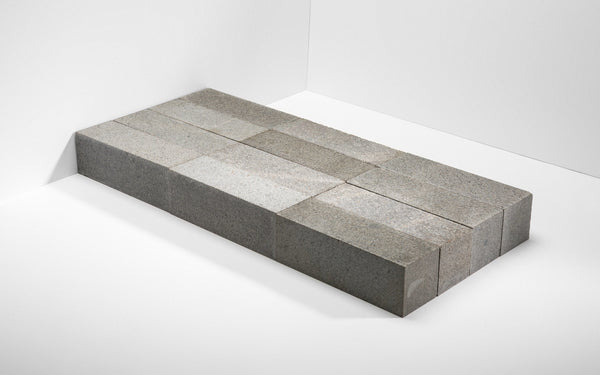
Carl Andre, Merrymount, 1992
Minimalist Painting
(Minimalism in Art: Definition, Characteristics and Artists - dans le gris)
Painting is a form of minimalism frequently encountered. Similar to minimalist sculptors, minimalist painters sought to create artworks with a strong sense of presence, emphasizing their essential physical attributes and intended for face-value appreciation. These paintings are typically devoid of expressive brushwork or intricate details.
Minimalist painters have created abstract works that incorporate repeated geometric and industrial shapes, devoid of significant thematic or emotional content. Among the earliest artists associated with minimalism is the painter Frank Stella, who played a pivotal role in the development of movements such as minimalism, post-painterly abstraction, and color field. Other celebrated minimalist painters include Ellsworth Kelly, Brice Marden, Kenneth Noland, and Robert Ryman.
(Minimalism in Art: Definition, Characteristics and Artists - dans le gris)
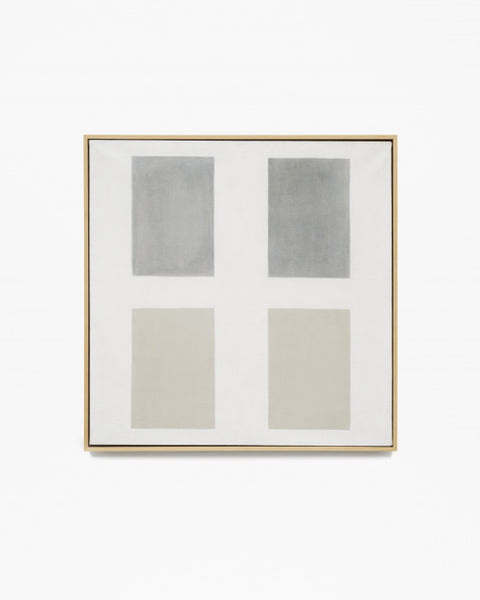
Agnes Martin, Window, 1957
(Minimalism in Art: Definition, Characteristics and Artists - dans le gris)
Minimalist Artists and Minimalist Artworks Examples
1. Robert Morris
(Minimalism in Art: Definition, Characteristics and Artists - dans le gris)
Robert Morris was one of the central figures of minimalism. During the 1960s, along with Donald Judd, he became one of the best-known exponents and theorists of minimalism. Through both his own sculptures from the 1960s and his theoretical writings, Morris presented a vision of art refined by simple geometric shapes, devoid of metaphorical associations, and focused on the interaction of the work with the viewer. This emphasis on perception and dimensional relationships was a key focus of minimalism.
Robert Morris's renowned "L-Beams" series stands as one of his most iconic minimalist creations. This collection features sizable L-shaped steel beams carefully positioned against the gallery walls. In doing so, Morris skillfully blurs the lines between sculpture, installation, and architecture. His deceptively simple sculptures present viewers with a subtle perceptual puzzle. Although all three elements share an identical shape, they take on different appearances due to their various orientations. Morris's art was dedicated to establishing a direct and unmediated connection between the viewer and the artwork itself.
(Minimalism in Art: Definition, Characteristics and Artists - dans le gris)
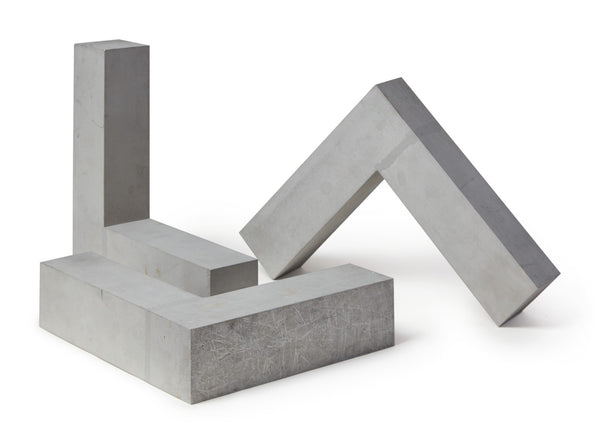
Robert Morris, Untitled (L-Beams), 1931-2018
(Minimalism in Art: Definition, Characteristics and Artists - dans le gris)
2. Carl Andre
(Minimalism in Art: Definition, Characteristics and Artists - dans le gris)
Carl Andre, an American minimalist artist, is best known for his significant contributions to the minimalism art movement in the mid-20th century. His artistic practice centers on simple, geometric forms that emphasize the essential qualities of materials. He succinctly expressed his philosophy with the statement, "Art is the exclusion of the unnecessary."
In the 1950s, his work evolved from painting and sculpture to what would become his signature style. He started creating sculptures from industrial materials, particularly raw, unaltered substances like bricks, steel plates, and wooden blocks. These sculptures were characterized by their geometric precision and their emphasis on the material itself, rather than any attempt at personal expression or symbolism.
One of Carl Andre's most famous works is the series of sculptures made from metal plates laid directly on the floor, known as "floor sculptures" or "tiles." These works challenged traditional ideas about sculpture by eliminating the pedestal and inviting viewers to engage with the artwork on the same plane, encouraging them to walk on the pieces and interact with the materials directly.
(Minimalism in Art: Definition, Characteristics and Artists - dans le gris)

(Minimalism in Art: Definition, Characteristics and Artists - dans le gris)
3. Frank Stella
(Minimalism in Art: Definition, Characteristics and Artists - dans le gris)
Frank Stella, an Italian American painter and printmaker, holds a significant place in the art world as a key figure in the "post-painterly abstraction" movement. His contributions played a pivotal role in steering painting away from the dominant influence of abstract expressionism and towards the emerging style of minimalism. This dual association with both abstract expressionism and minimalism has sparked a discussion among art historians and critics regarding Stella's relationship with minimalism. Although most of his later artworks do not strictly adhere to minimalism, his early works anticipated many elements of the movement, leading some to consider him a minimalist artist as well.
(Minimalism in Art: Definition, Characteristics and Artists - dans le gris)
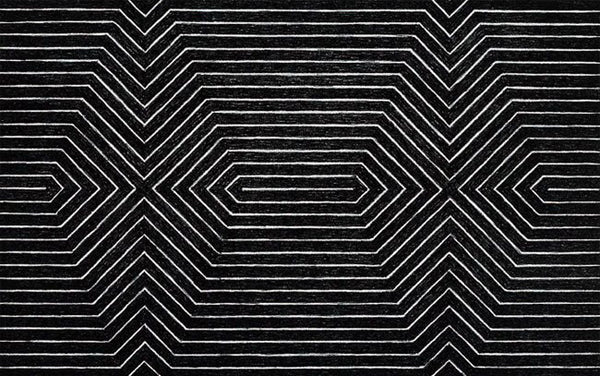
Frank Stella, Turkish Mambo from Black Series II, 1967
(Minimalism in Art: Definition, Characteristics and Artists - dans le gris)
4. Dan Flavin
(Minimalism in Art: Definition, Characteristics and Artists - dans le gris)
Dan Flavin was an American artist best known for his seminal installations of light fixtures. His art is often associated with the minimalist art movement because it aligns with the movement's principles, aiming to reduce art to its essential elements, emphasizing simplicity, geometric forms, and the use of industrial materials. However, his choice of medium was unconventional: fluorescent light tubes. Flavin was one of the first minimalist artists to explore the concept of real space as a formal element, using industrial materials and simplified forms to create his art.
(Minimalism in Art: Definition, Characteristics and Artists - dans le gris)
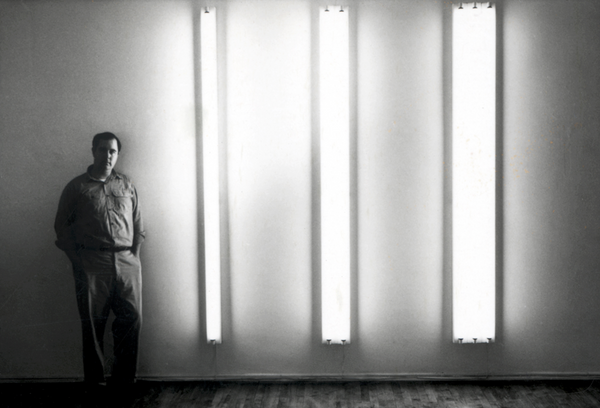
Dan Flavin, The Nominal Three (to William of Ockham), 1963
5. Anne Truitt
(Minimalism in Art: Definition, Characteristics and Artists - dans le gris)
Anne Truitt was an American minimalist sculptor who gained prominence in the late 1960s for her large-scale minimalist sculptures. Unlike many of her fellow minimalist artists, she did not shy away from color; in fact, she made it the central point of interest in her work. The subtlety of color was meticulously applied to her sculptures, sometimes with as many as forty layers. Truitt's work emphasized the relationship between color, form, and space, laying the groundwork for the minimalism art movement's exploration of these aspects.
(Minimalism in Art: Definition, Characteristics and Artists - dans le gris)
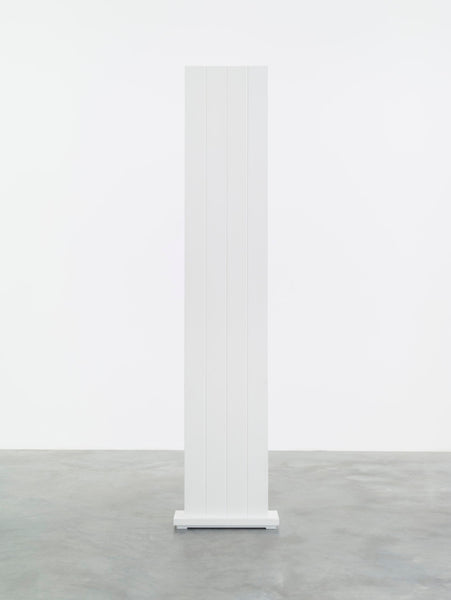
Anne Truitt, White: Four, 1962
6. Sol LeWitt
(Minimalism in Art: Definition, Characteristics and Artists - dans le gris)
Sol LeWitt was an American artist often associated with minimalism and conceptual art. While many minimalist artists turned to industrial materials, LeWitt simplified even further, still employing traditional materials. For LeWitt, the process of creating a work of art became the artwork itself, and an artwork was no longer required to have an actual material existence. His art often involved simple geometric shapes, such as cubes, spheres, and pyramids, and it also extended to wall drawings and structures.
• Further Reading: What is Conceptual Art? Art is Not About the Object?
(Minimalism in Art: Definition, Characteristics and Artists - dans le gris)
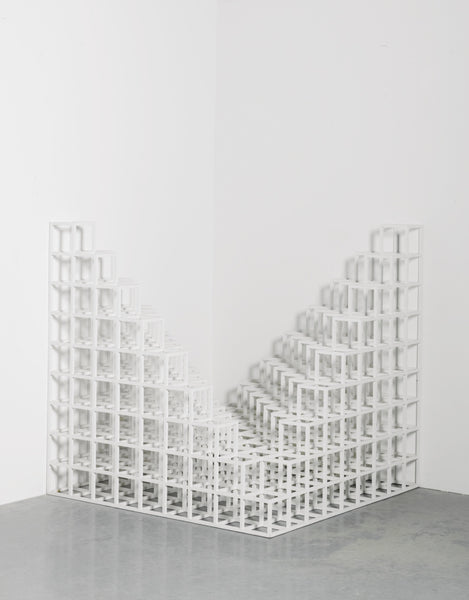
Sol Lewitt, Corner Piece #4, 1976
7. Donald Judd
(Minimalism in Art: Definition, Characteristics and Artists - dans le gris)
Donald Judd was an influential American artist and a prominent figure in the minimalism art movement. Although he himself rejected the term "Minimalism," it is likely because the term had previously been associated with negative connotations. However, people often associate Donald Judd with minimalism because his artwork often features simple, geometric shapes such as cubes, rectangles, and squares, which are typical of minimalism. Judd also believed that art should exist independently, free from external associations and symbolism, just like other minimalist artists. While some critics and art historians debate whether Judd's work is strictly minimalism, there is no doubt that his art played a pivotal role in shaping the movement.
(Minimalism in Art: Definition, Characteristics and Artists - dans le gris)
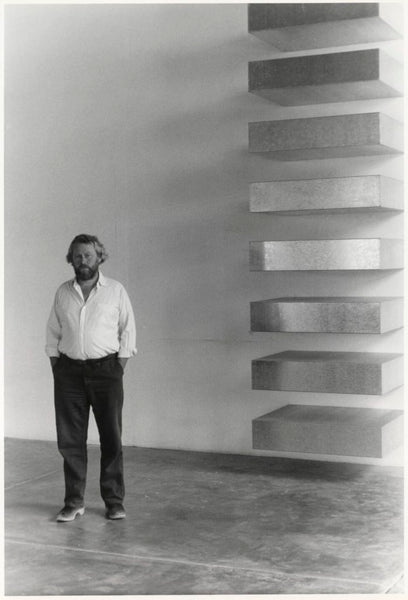
Donald Judd and his artwork "Untitled' (Stacks)"; Made from industrial materials such as stainless steel or Plexiglas
8. Agnes Martin
(Minimalism in Art: Definition, Characteristics and Artists - dans le gris)
Agnes Martin was a Canadian-American painter renowned for her distinctive contributions to abstract art, particularly in the realms of minimalism and abstract expressionism. Martin's artistic endeavors are marked by a profound exploration of pure abstraction, frequently showcasing grids and geometric patterns. Her creative expressions were significantly influenced by her fascination with Eastern philosophy, notably Taoism, and she held the belief that her art sought to evoke sentiments of transcendence and inner tranquility.
(Minimalism in Art: Definition, Characteristics and Artists - dans le gris)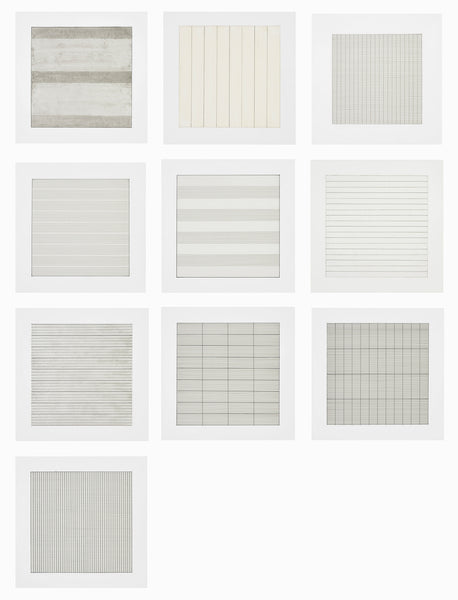
Agnes Martin Painting and Drawings 1974-1990
Throughout her career, Martin created paintings characterized by repetitive and meticulously hand-drawn lines, often using soft and muted colors. Her unique style is frequently interpreted through the lens of abstract expressionism, but visually, it bears a closer resemblance to minimalism. Martin's creations mostly comprised square-format monochromes with penciled grids, providing a serene departure from the bold, emotional, and highly gestural art that dominated the New York art scene during her time.
9. Ellsworth Kelly
(Minimalism in Art: Definition, Characteristics and Artists - dans le gris)
Ellsworth Kelly was an American painter, sculptor, and printmaker whose work embodies the avant-garde of post-war abstraction. Alongside artists like Mark Rothko and Kenneth Noland, Kelly's paintings represent the color-field counterpart to the gestural abstraction of Pollock and De Kooning. Similar to Frank Stella, Ellsworth Kelly played a role in advancing the development of minimalism and the creation of reductive paintings during the 1960s and 70s. Unlike many of his contemporaries, Ellsworth Kelly showed no interest in expressing emotion, creating concepts, or telling a story with his art. Instead, he was intrigued by the act of viewing and the space between the painting and the person observing it. Due to his use of isolated bright colors and simple shapes, his work is considered a part of minimalism.
(Minimalism in Art: Definition, Characteristics and Artists - dans le gris)
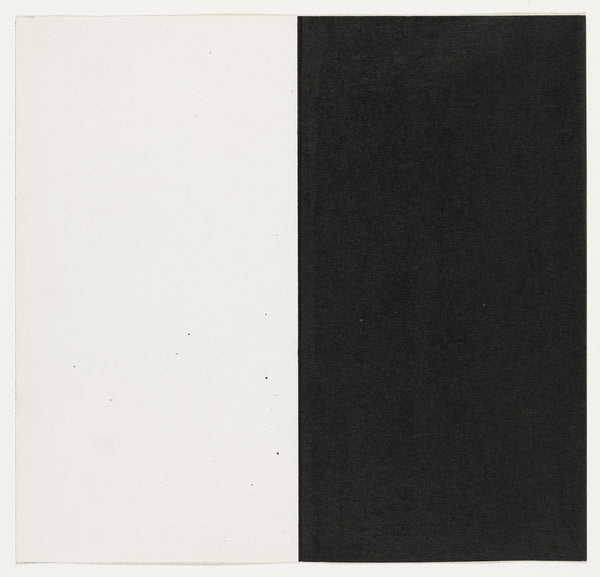
Ellsworth Kelly, White and Black, 1951
10. Robert Ryman
(Minimalism in Art: Definition, Characteristics and Artists - dans le gris)
Robert Ryman is considered one of the leading pioneers of minimalist painting, alongside renowned artists such as Frank Stella and Sol LeWitt. One of the defining features of Ryman's work is his exploration of white as a primary color. He stated, "I don’t think of myself as making white paintings; I make paintings. I’m a painter. White paint is my medium." This statement conveys the radical practice that the artist began in the mid-1960s, narrowing the focus of his work to white paint alone.
(Minimalism in Art: Definition, Characteristics and Artists - dans le gris)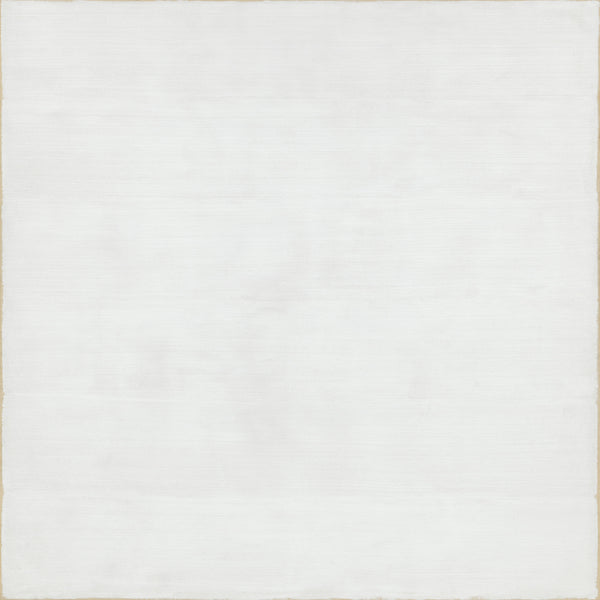
Robert Ryman, Twin, 1966
In one of Ryman's artworks, "Twin," the canvas's surface is covered with tightly tiered rows of white brushstrokes, executed in a single motion across an unprimed canvas. The scale of this work necessitated the use of a specially made twelve-inch brush and thinned paint, allowing Ryman to complete each horizontal stroke without interruption. "Twin" embodies several principles of minimalism, including the reduction of elements to their essential qualities and an emphasis on the relationship between the artwork and the viewer.
Conceptual Art and Minimalism
(What is Conceptual Art? Art is Not About the Object? - dans le gris)
Minimalism and the conceptual art movement of the 1960s and 1970s revolutionized our comprehension of space and materials. While conceptual art and minimalism are distinct movements, they occasionally intersect, as some artists blend elements of both in their work. For instance, both conceptual art and minimalism often prioritize simplicity in their visual presentation. Minimalism reduces art to its most basic forms, while conceptual art may employ minimal aesthetics to direct attention to the idea. Moreover, conceptual art and minimalism both engage viewers on an intellectual level. Minimalism encourages viewers to contemplate the essence of the form, while conceptual art invites intellectual reflection on the concept or idea.
The most significant way to distinguish between minimalism and conceptual art is their focus. Minimalism centers on the visual and formal qualities of the art object, emphasizing the relationship between form, space, and materials. In contrast, conceptual art prioritizes the concept or idea behind the artwork, often downplaying the visual or aesthetic qualities. Furthermore, minimalism often uses traditional artistic mediums, such as sculpture and painting, with a focus on their physical properties. But conceptual art can encompass a wide range of mediums, including text, language, installations, and performances.
(Minimalism in Art: Definition, Characteristics and Artists - dans le gris)
Continue Reading:
• What is Conceptual Art? Art is Not About the Object?
• Minimalist Interior Design: Key Principles and What You Need to Know
• Minimalism vs. Wabi Sabi: Embracing Simplicity in Design and Life
• Fluxus Art Movement: Definition, Artists and Examples
(Minimalism in Art: Definition, Characteristics and Artists - dans le gris)
About Us
Dans Le Gris is a brand that began with everyday jewelry, fusing minimalist and artistic elements. Our objective is to enrich daily life with designs that are pure, timeless, and unique.
(Minimalism in Art: Definition, Characteristics and Artists - dans le gris)
In our journal, we provide irregular updates featuring articles about art, culture, and design. We aspire to furnish our readers with profound insights and inspiration across a broad array of creative subjects. From the daily inspirations found in art and design to the timeless beauty of traditional craftsmanship and philosophy, our curated content encompasses diverse aspects of life. We hope you enjoy our content, and thank you for being here.

